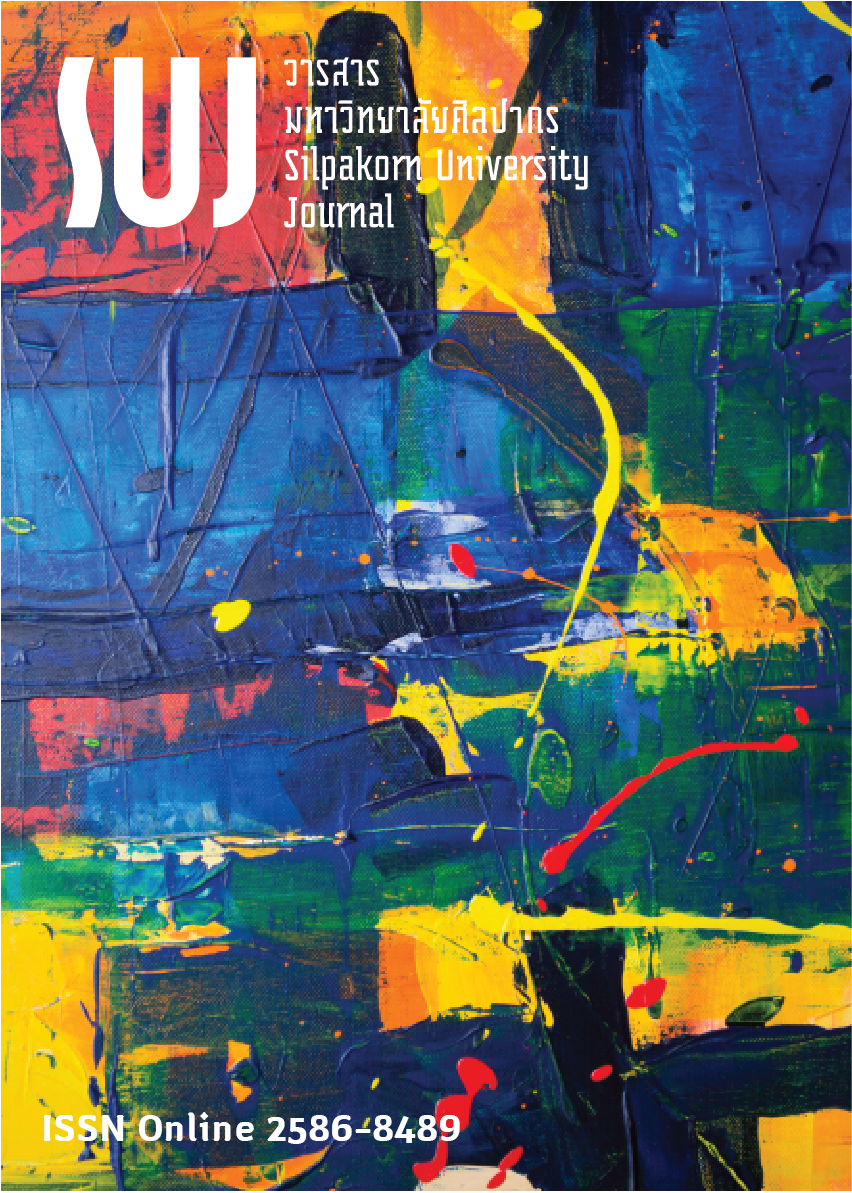การประยุกต์ใช้นวัตกรรมเส้นใยฟิลาเจนร่วมกับเส้นใยธรรมชาติสู่ผลิตภัณฑ์ถุงเท้า (The application of innovative filagen fibers in combination with natural fibers)
Main Article Content
Abstract
งานวิจัยนี้มุ่งศึกษาการประยุกต์ใช้นวัตกรรมเส้นใยฟิลาเจนร่วมกับเส้นใยธรรมชาติเพื่อสร้างผลิตภัณฑ์ถุงเท้าย้อมสีครามธรรมชาติ ผู้วิจัยใช้เส้นใยธรรมชาติ 3 ชนิด ได้แก่ เส้นใยผักตบชวา เส้นใยสับปะรด และเส้นใยกล้วย โดยนำเส้นใยธรรมชาติเหล่านี้ไปผสมกับเส้นใยฟิลาเจนในอัตราส่วนต่าง ๆ แล้วจึงนำผลมาวิเคราะห์ร่วมกับผู้เชี่ยวชาญด้านการผลิตเส้นด้ายจากบริษัท ก้องเกียรติ เท็กไทล์ จำกัด ด้วยการวิเคราะห์ความเหมาะสมจากลักษณะของเส้นใยธรรมชาติ สูตรการผสม คือ เส้นใยฟิลาเจน ร้อยละ 25 เส้นใยธรรมชาติ ร้อยละ 15 และเส้นใยฝ้าย ร้อยละ 60 ด้วยระบบการปั่นเส้นด้ายแบบ Open-End Spinning (OE) เพื่อผลิตเส้นด้ายเบอร์ 20/1 Denier จากนั้นผู้วิจัยทดสอบสมบัติทางกายภายของเส้นด้ายผสมผักตบชวา เส้นด้ายสับปะรด และ เส้นด้ายกล้วยตามลำดับด้วยกล้อง Scanning Electron Microscope (SEM) ผลการวิเคราะห์พบว่า ลักษณะของเส้นด้ายผสมหลังปั่นทั้ง 3 ประเภทคล้ายคลึงกัน แต่เส้นด้ายสับปะรดมีความเรียบของเส้นด้าย และมีลักษณะการเข้าเกลียวของเส้นใยแต่ละชนิดได้เรียบมากที่สุด นอกจากนี้เมื่อนำเส้นด้ายไปทำถุงเท้าและย้อมสีครามธรรมชาติ พบว่าเส้นใยเหล่านี้สามารถผลิตเป็นถุงเท้าได้และมีความยืดหยุ่นดีเพียงพอ ในขณะที่เมื่อนำไปย้อมสีครามธรรมชาติด้วยการมัดย้อมซึ่งให้เกิดลวดลาย พบว่า เส้นด้ายที่ผสมทั้ง 3 ชนิดดูดสีครามได้ดี ดังนั้น เส้นใยผสมชนิดใหม่เหล่านี้สามารถนำไปใช้งานได้หลากหลายในด้านสิ่งทอและในเชิงพาณิชย์ได้
This research aimed at studying an application of the innovative filagen fibers combined with natural fibers in order to produce natural indigo dyed socks. There were three types of natural fibers, namely water hyacinth fiber, pineapple fiber, and banana fiber. These natural fibers were blended with filagen fiber with different ratios. Then, researchers synergized with yarn expert producers from Kongkiat Textile Company Limited. These yarns were analyzed their suitability and quality based on their natural fibers’ characteristics. The mixing formula comprised 25% of filagen fibers, 15% of natural fibers, and 60% cotton fibers with an open-end spinning (OE) yarn spinning system. This focused on creating the yarn number 20/1 Denier. Afterward, these three natural mixed yarns were tested their physical properties by employing the Scanning Electron Microscope (SEM) camera for their validity, accordingly. It was found that the characteristics of these mixed natural yarns after spinning were similar. In particular, the pineapple yarn was likely to be the smoothest in terms of its texture’s surface and threading smoothness. These yarns can be used to produce socks with elasticity and flexibility satisfactory. In addition, these yarns were not only good at exhibiting clear patterns derived from the tie-dying technique but also good at absorbing indigo substance very well. Therefore, these natural mixed fibers should be considered as new types of fibers that can be used in a variety of commercial textile applications and weaving industries.
Downloads
Article Details

This work is licensed under a Creative Commons Attribution-NonCommercial-NoDerivatives 4.0 International License.
References
Chonsakorn, Sakorn, Srivorradatpaisan, Supanicha, & Mongkholrattanasit, Rattanapon. (2018). Effects of different extraction methods on some properties of water hyacinth fiber. Journal of Natural Fibers, 16(7): 1015-1025.
Chemsripong, Sujinda, & Petmee, Piyawan. (2017). Creating Value Added Products from Local Wisdom: A Case Studdy of the Ancient Cloth (การสร้างมูลค่าเพิ่มของผลิตภัณฑ์จากภูมิปัญญาท้องถิ่นไทย : กรณีศึกษาผ้าทอลายโบราณ). Journal of Community Development Research (Humanity and Social Sciences), 10(4): 62-85.
Umasin, Nawatthakorn, & Utiswanakul, Patcha. (2018). Inovative Textiles from Etlingera Elatior Fiber to Fashion Lifestyle (นวัตกรรมสิ่งทอจากเส้นใยดาหลาสู่การออกแบบผลิตภัณฑ์แฟชั่นไลฟ์สไตล์). Veridian E-Journal, Silpakorn University, 11(3): 803-814.
Wongrujiwanit, Suwit. (2011). Sustainable Design (ดีไซน์ เปลี่ยนโลก). Bangkok: Bangkokbusiness Publishing.


